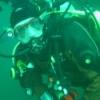(edited for brevity) ...So lets reduce the importance of the buddy initially. Let's get Joe or Jill diver to the point where they can handle 95%+ of the issues and gear failures without a buddy's assistance. We can still have the buddy around for insurance, but even if they disappear completely the diver is still fine and has a very good chance of getting to the surface safely on their own merits.
So essentially I am saying let us look at the training and equipment most OW divers get and see what we can do to improve it... The key, in my mind at least, is to teach the diver to be self-reliant first wherever possible. Build redundancy into their gear as soon as practicable and let them know that responsibility and personal safety comes from them and not some faceless buddy.
Agreed on all points! I would also add that if you are a spearfishing diver, or a photo/videographer diver, then you should be even more concerned about becoming self-reliant, because even if you start your dive with a buddy, when chasing that fish to shoot you may find yourself suddenly alone and buddyless more often than not. I'm definitely into photography, which is why a couple months ago I started seriously looking into this matter, and with my AOW cert behind me I have decided that the next certification I want to go for is the
Solo Diver cert, which is only offered right now by one agency: SDI.
(Side note: Interestingly, the Solo cert is not offered through their technical arm, TDI, even though Solo is considered an advanced/technical cert, but I think that's because the whole Solo diver thing is still rather controversial in the diving world right now.)
Part of the minimum requirement for the Solo cert is 100 logged dives. I'm hoping to have that tally by end of this year, and then get my cert early next year. Aside from the minimum number of dives, the rest is mostly demonstrated skills. Feedback I've read from experienced divers taking the course say it's nothing special - they didn't really learn anything surprisingly new. But that makes sense: you really shouldn't be learning new material in your Solo course so much as demonstrating competency with your gear and training sufficient for self-rescue to earn your cert.
I think there are really three major categorical concerns as a solo diver (which of course are really concerns for
all divers, but if you're going to call yourself "self-reliant" you should at least be prepared for these):
- Low On Air/Out Of Air situations.
- Entanglement.
- Surface Survival.
These have mostly been addressed within this thread, to wit:
#1 Concern: Low On Air/Out Of Air...If Diver A can handle the LOA/OOA situation by themselves then if there is a buddy separation, a slow and controlled ascent can be done and it does not result in injury. How? Pony bottle. Yes, there are Spare Airs and doubles on either side of that solution and they are in no way invalid. Something is better than nothing. A Pony or Bailout Bottle is designed for one purpose. Getting a REC diver to the surface (Or at least a lot shallower) than they would ordinarily be.
Pony size would depend on the depth or dive profile. Doubles are for more technical profiles requiring speciality training and overkill for OW divers in this example. Training could be simplified to the point of "Once you or your buddy are on your Pony, the dive ends..."
For any diver even considering describing themselves as self-reliant, a pony is a MUST (unless, as Sha mentiontioned, you're a techie with doubles or some other form of redundant gas supply). Once I decided on going for the Solo cert, I knew the first thing I needed to do was to start figuring out exactly what kind of pony I needed and how I would carry it.
Luckily, a techie buddy was able to loan me his 13 cubic foot pony he used to use as a rebreather bailout, so I could start experimenting. Believe me, adding a pony is not simple, if only because of the myriad choices you must make: how big a pony? steel or aluminum? what kind of valve and reg? how to carry it: slung across, slung underarm, strapped to tank, strapped in bag? left or right? upright or inverted? valve open or closed? reg on a long hose or short hose, or hard-mounted?
Every one of these choices about your pony has pros and cons: the right way is what works best and most intuitively for you, but until you try them out, you won't know!
My own decision? After playing around quite a bit, I decided on kind of an odd route: I'm going with a Luxfer aluminum 19 cubic foot cylinder, which should be able to get me safely to the surface with a standard safety stop even when breathing hard from 130' - the rec depth limit. That in itself isn't strange, but my choice in valve and reg is: I went for the
Zeagle Razor, an oddball combination valve and first stage that saves size and weight over traditional separates. And, also kind of odd, I decided to carry it bagged (a bag that hangs off your main cam band), upright, left-sided, short-hosed (but with one of the new flexi-hoses), and valve-on, with the second stage necklaced. My logic is: the combo valve/reg saves space and weight, and adds reliability in that there's one less seal to leak, and bagged so if my entire main rig is entangled I can worst case remove the pony from the bag fairly easily and ascend only on that - or remove it and give it to an ailing buddy. The Luxfer 19 buoyancy characteristics are nearly ideal: about -1.4 pounds buoyant full, and barely +0.1 pound buoyant empty, so it has minimal impact on my lead ballast, whether I keep it or give it away.
My new pony is still at the shop being assembled: there's a button pressure gauge and low-pressure relief valve to add as well as mounting the reg. But I can tell you that I tested ascending entirely on the 13 cu.ft. pony from 75 fsw at Jupiter the other weekend and made it to the surface with air to spare even after a standard safety stop. Keep in mind, that's breathing normally - my SAC is usually about .72, but my calculations for the 19 cu.ft. pony from 130' are based on a heavy-breathing SAC of 1.0.
But the main point is: figure out how to carry your pony, and dive with it all the time. It should be like the spare tire in your car: you may never use it, but when you do, you absolutely need it to work, and you need it full of air. You cannot even begin to be self-reliant without a pony bailout!
#2 Concern: Entanglement...How about: Whistle or air horn, time-piece, SMB (reel optional, but nice to have for free ascent SS), knife (X2 - primary and backup), flashlight (X2 - primary and backup) and mirror. Would cost under $200 for all that, but give a lot more chances of survival if things go wrong.
Shadragon addressed both my #2 and #3 concerns with this, but I want to focus on #2, entanglement. I believe the actual recommendation for a solo diver here is to carry THREE cutting tools: two knives (or a knife and a Z-knife), and also a pair of EMT shears. The primary dive knife is a given. The Z-knife is especially good at cutting through monofilament and netting, and the shears are necessary for tough thick things like stainless steel wire that is often used as fishing leaders these days. EMT shears are very strong and versatile and can also cut through heavy webbing to extricate yourself from an entangled BC or the like.
In addition to
having the cutting tools, you must take into consideration how you get at them. Preferably they should be accessible with either hand alone, in case the other is entangled. Again, the right place to put them is wherever works for you! My knife is on my BC, my Z-knife is on my chest strap, and I'm planning on mounting a side pocket to my wetsuit leg that will hold my shears.
#3 Concern: Surface SurvivalWe focus a lot on underwater contingencies - but I can tell you first hand it is VERY hard to see a person on the surface at any distance, especially in any kind of sea state. If you dive in remote areas, I'd give some serious thought to including the following:
- Some water
- A signalling mirror
- EPIRB (emergency radio beacon - if you invest, go for one with built-in GPS)
- A second SMB
- Dye marker
- Small Dive light
- A strobe
- A hat
Jack covers my #3 concern, Surface Survival, pretty darned well here. In fact, I carry all these items (except an EPIRB), either in my BC pockets, or in the little ditty bag at the end of my DAN safety sausage, which I cannot recommend highly enough.
The
DAN safety sausage/SMB is a very well thought-out device, not only for including the bag at the bottom to hold most of your surface survival gear, but also because it includes a slot at the top for a cyalume stick or other night beacon, has a reflective strip along the entire length, is generously sized yet rolls compact, can be inflated orally or with your LP hose, has an additional dump valve, comes with a whistle and mirror, has a decent lift capacity, and can even be wrapped around yourself and clipped like a traditional O-float for long-duration spells above water where you may need to sleep.
In addition, in my DAN sausage bag I also carry a tiny roll of duct tape and one of those "space blankets". The blanket is just a big piece of metallized Mylar, but packs incredibly small and is so versatile: with it and a bit of duct tape you can
make yourself a hat or mini-tent to escape the sun, you can cut it into ribbons and string them together for a very long and visible daylight streamer, and my understanding is you can wad up what's left into a ball that is highly reflective to radar. Remember: being visible and heard is great, but the Coast Guard copter looking for you can see much farther with their radar than with their eyes and ears! All this versatility for very little space consumed (about the size of a deck of cards).
So, those are three main concerns for a solo diver - or any diver wishing to be self-reliant and independent of a buddy - and ideas about addressing them. The important thing, however, is not just to have the equipment, but to be comfortable with it, to get used to carrying it on
every dive, and - as always - to have the presence of mind not to panic, but rather use the one tool most important over any other:
your brain.
Ultimately, I still plan to do most of my diving with buddies, preferably people I know and trust. I'm going for the Solo cert - and the equipment and training that goes along with it - mostly for the peace of mind that comes with the knowledge that I am as self-reliant as I can reasonably be.
As to whether or not all this should be taught as part of basic open water... I'm not sure. I think the buddy system does pretty well, for what it is. I know in my case when I started out I really just wanted to get my OW cert and start diving. Most of what I've really learned has been after that, with experience, and keep in mind we are talking about a lot of extra equipment here, so task-loading the neophyte diver is also a serious consideration. I think a better case could be made to make solo-type self-rescue training part of an AOW cert.
Anyway, that's just my opinion and experience to share on this matter. Keep in mind, I'm still learning as I go...
>*< Fritz
















